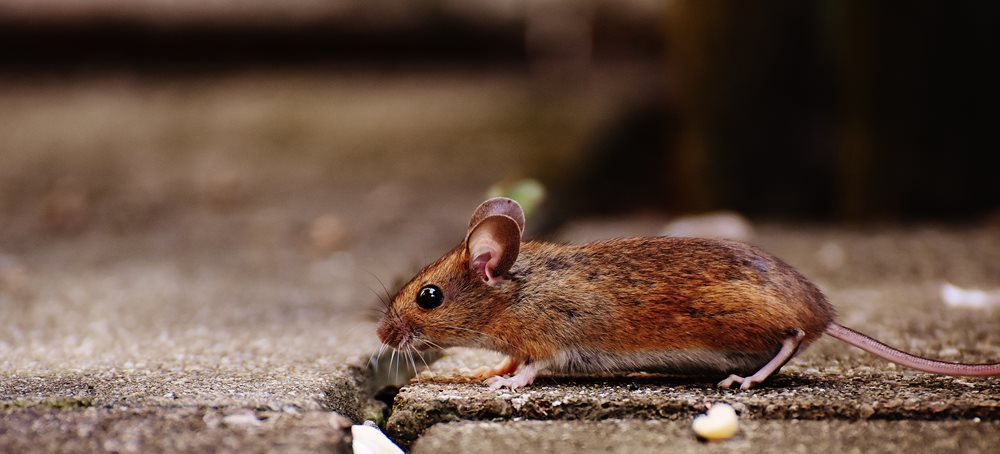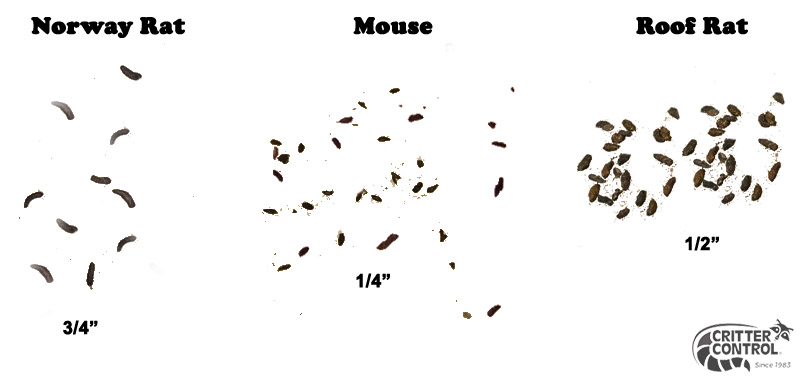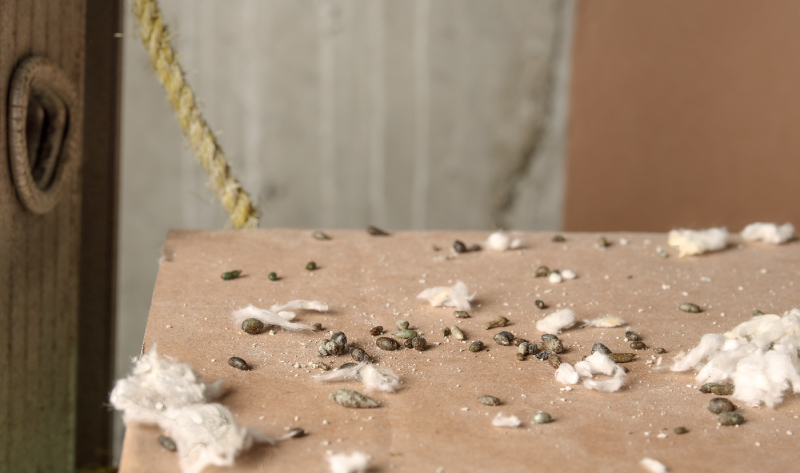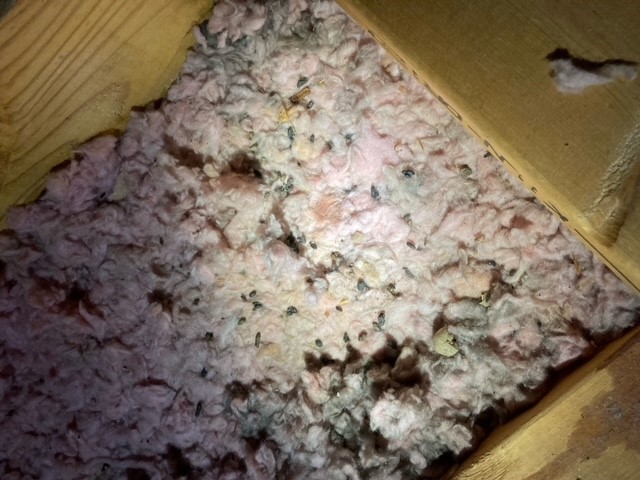
While about 1,500 rodent species exist, the most common rodents living in your house are rats, mice, and squirrels. These rodents avoid people, so seeing one in your home is rare. They still leave physical evidence of the infestation behind. The most obvious sign of a rodent infestation is droppings.
Mouse Droppings vs Rat Droppings

Mice and rats are nocturnal, stealthy, and well-adapted to staying out of sight. The first sign of an infestation is often the identification of rodent droppings in or around the house.
. Since rats are larger, their droppings will be larger as well. Rat droppings are generally 3/8 inches long, with a diameter of 1/8 of an inch. Mice droppings are about half this size. Both are oblong pellets, but rat droppings have rounded tips, and mice have pointed tips. Mouse poop is dark-colored and about the size of a rice kernel, while rat scat is black and bean-sized.
Squirrel Droppings vs Rat Droppings

While both rat and squirrel droppings can be dark brown to black with blunted ends, they are found in different places around the home. Squirrel droppings are often found in attics or around tree trunks, while rat droppings are more common along baseboards, in cupboards, and behind large appliances like washing machines.
Where to Find Rodent Droppings in the House
Homeowners can also look for rodent scat in the following places:
- Near improperly stored garbage
- Behind shelves, stoves, and tables along the wall
- In attics and wall voids
Rat and mouse feces typically show up in garages, kitchens, bedrooms, and other areas the pests frequent. Not only are these pellets unsightly, but they fill the room with a foul, musty odor.
Squirrels rarely enter the living spaces of your homes. Squirrel poop will be in the attics, on your roof, or inside the walls.
Rodent Diet
Rats and mice prefer to eat fresh food, but they can live their entire lives on nothing but garbage. An ounce of rotting food and dirty water is all it takes to keep a rat alive for one day. It also provides plenty of fuel to create piles of rodent droppings. This survival skill makes it hard to simply starve out or wait out an infestation. As a general rule, for every visible mouse or rat, about 25 more remain unseen.
A squirrel’s diet contains various food items, including leaf buds, wild fruits, nuts, acorns, bird eggs, and even tree bark. However, while they appreciate readily available foods found in nature, they’re opportunistic feeders that will forage in various places, including your property.
Rodent Feces Contamination
When mice and rats make their way indoors, they search for food in kitchens and pantries. The pests can easily gnaw through packaging and taint the contents with rodent feces and urine. Since this waste can transmit Hantavirus and salmonellosis, it’s a serious threat to residents.
Rats and mice contaminate as much as 10 times the food they eat. As soon as rodent poop is identified in pantries or cupboards, it is safest to get rid of anything not stored in a tightly-sealed container. Heavy-duty materials like metal, thick plastic, and glass are the most rodent-proof.
How to Clean Up Rodent Poop According to Critter Control
Do not vacuum up mouse, rat, or squirrel droppings!
Diseases are mainly spread by mice when you breathe contaminated air. Sweeping and vacuuming can cause tiny droplets to get into the air. Taking precautions when cleaning up mouse droppings is essential to protect yourself from potential health risks.
If you are going to attempt DIY rodent cleaning on your own, protect yourself. Wear a mask or respirator and rubber or plastic gloves.
Ventilate the area for 30 minutes before cleaning. Spray the area with a bleach-water solution or a household disinfectant and wait five minutes. Wipe up the droppings with a paper towel and throw it away. Mop or sponge the area with a disinfectant. Cleaning up soft materials like carpets, clothing/bedding/stuffed animals, books, or paper, follows the CDC’s guidelines.
Critter Control’s rodent control program includes clean-up and sanitization. Rodent infestations are common in attics which leads to the contamination of insulation and air ducts. Rodent droppings in the insulation and air ducts can be a significant health risk to you and your family.
Additional Problems from Rodent Droppings
Even if not directly consumed, rat or mouse waste may still transfer disease. An act as simple as moving rodent scat can release infected particles into the air. Never vacuum or sweep rodent poop, urine, or nesting material in an attempt to clean up.
Before cold weather begins, seal structural gaps or any small entry points into the home. This will reduce the possibility of rodent droppings showing up indoors. However, it can be difficult to identify every crevice. Reach out to Critter Control for professional rodent control and removal.
Get them out.
Keep them out.®
Experiencing a wildlife or pest issue? We can help! Complete this form and your local Critter Control® office will contact you to assist.
- Difference between Mice and Rats
- Rodent Caused House Fires
- Do Rodents Hibernate?
- Rodent Deterrents
- Rodent Diseases
- Rodent Nests
- Rodent Noises
- Rodent Repellents
- Rodent Tracks
- Rodents under the House, Deck, or Floor
- Rodents in the Attic
- Rodents in Walls
- Types of Rodents
- Rat Noises
- Mouse Noises
- Squirrel Noises
